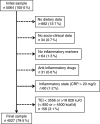Association between dietary intake and inflammatory markers: results from the CoLaus study
- PMID: 30333073
- PMCID: PMC10260662
- DOI: 10.1017/S1368980018002355
Association between dietary intake and inflammatory markers: results from the CoLaus study
Abstract
Objective: To assess the associations between single foods, nutrients, dietary patterns and dietary scores, and inflammatory markers (C-reactive protein (CRP), IL-6, TNF-α and leucocyte count).
Design: Cross-sectional, population-based study.
Setting: City of Lausanne, Switzerland, years 2009-2012.
Subjects: Adults (n 4027; 46·5 % men), mean age 57·2 (sd 10·2) years. Dietary intake was collected using a semi-quantitative FFQ. Single foods and nutrients, three dietary patterns ('Meat & fries'; 'Fruits & vegetables'; 'Fatty & sugary') and three dietary scores (two Mediterranean; Alternative Healthy Eating Index (AHEI)) were used. Associations were assessed using correlation and multivariable linear regression.
Results: After adjusting for total energy intake, gender and other sociodemographic factors, no individual macro- or micronutrient was associated with inflammatory markers. Among single foods, only fruit intake was negatively associated with CRP levels (standardized regression score=-0·043, P<0·01). The 'Fruits & vegetables' pattern, the Mediterranean and the AHEI scores were negatively associated with CRP levels (standardized regression score=-0·079, -0·043 and -0·067, respectively, all P<0·01). When entered simultaneously with fruit intake, the 'Fruits & vegetables' pattern, the Mediterranean and the AHEI scores tended to remain significantly and negatively associated with CRP levels, while the association with fruit intake was no longer significant. No association between all dietary markers and IL-6, TNF-α or leucocyte count was found.
Conclusions: Dietary scores, but not individual foods, are associated with inflammatory markers in the general population.
Keywords: Dietary patterns; Dietary scores; Epidemiology; Inflammation; Nutrients.
Figures
Similar articles
-
Socio-demographic and lifestyle determinants of dietary patterns in French-speaking Switzerland, 2009-2012.BMC Public Health. 2018 Jan 12;18(1):131. doi: 10.1186/s12889-018-5045-1. BMC Public Health. 2018. PMID: 29329572 Free PMC article.
-
Dietary factors and biomarkers of systemic inflammation in older people: the Lothian Birth Cohort 1936.Br J Nutr. 2015 Oct 14;114(7):1088-98. doi: 10.1017/S000711451500210X. Epub 2015 Sep 7. Br J Nutr. 2015. PMID: 26343358 Free PMC article.
-
Impact of dietary and obesity genetic risk scores on weight gain.Am J Clin Nutr. 2021 Aug 2;114(2):741-751. doi: 10.1093/ajcn/nqab069. Am J Clin Nutr. 2021. PMID: 33831948
-
Associations of Dietary Intake on Biological Markers of Inflammation in Children and Adolescents: A Systematic Review.Nutrients. 2021 Jan 25;13(2):356. doi: 10.3390/nu13020356. Nutrients. 2021. PMID: 33503979 Free PMC article.
-
Dietary patterns and associations with biomarkers of inflammation in adults: a systematic review of observational studies.Nutr J. 2021 Mar 12;20(1):24. doi: 10.1186/s12937-021-00674-9. Nutr J. 2021. PMID: 33712009 Free PMC article.
Cited by
-
Nutrition and Cardiovascular Health.Int J Mol Sci. 2018 Dec 11;19(12):3988. doi: 10.3390/ijms19123988. Int J Mol Sci. 2018. PMID: 30544955 Free PMC article. Review.
-
Associations between healthy food groups and platelet-activating factor, lipoprotein-associated phospholipase A2 and C-reactive protein: a cross-sectional study.Eur J Nutr. 2024 Mar;63(2):445-460. doi: 10.1007/s00394-023-03277-8. Epub 2023 Dec 8. Eur J Nutr. 2024. PMID: 38063929 Free PMC article.
-
The Use of Healthy Eating Index 2015 and Healthy Beverage Index for Predicting and Modifying Cardiovascular and Renal Outcomes.Curr Nutr Rep. 2022 Sep;11(3):526-535. doi: 10.1007/s13668-022-00415-2. Epub 2022 Apr 27. Curr Nutr Rep. 2022. PMID: 35476188 Review.
-
Diet Inflammatory Index among Regularly Physically Active Young Women and Men.Nutrients. 2023 Dec 25;16(1):62. doi: 10.3390/nu16010062. Nutrients. 2023. PMID: 38201892 Free PMC article.
-
Associations of Dietary Inflammatory Potential with Esophageal Precancerous Lesions and Esophageal Squamous-Cell Cancer: A Cross-Sectional Study.Nutrients. 2023 Sep 21;15(18):4078. doi: 10.3390/nu15184078. Nutrients. 2023. PMID: 37764860 Free PMC article.
References
-
- Luc G, Bard J-M, Juhan-Vague I et al.. (2003) C-reactive protein, interleukin-6, and fibrinogen as predictors of coronary heart disease: the PRIME study. Arterioscler Thromb Vasc Biol 23, 1255–1261. - PubMed
-
- Fung TT, McCullough ML, Newby PK et al.. (2005) Diet-quality scores and plasma concentrations of markers of inflammation and endothelial dysfunction. Am J Clin Nutr 82, 163–173. - PubMed
-
- Pounis G, Bonaccio M, Di Castelnuovo A et al.. (2016) Polyphenol intake is associated with low-grade inflammation, using a novel data analysis from the Moli-sani study. Thromb Haemost 115, 344–352. - PubMed
-
- Muka T, Kiefte-de Jong JC, Hofman A et al.. (2015) Polyunsaturated fatty acids and serum C-reactive protein: the Rotterdam study. Am J Epidemiol 181, 846–856. - PubMed
Publication types
MeSH terms
Substances
LinkOut - more resources
Full Text Sources
Research Materials
Miscellaneous


